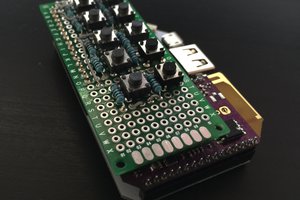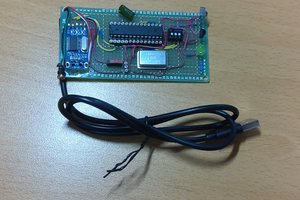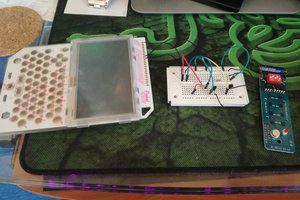The process:
The RF commands were learnt using the fan remote and SDR-Sharp software with a USB to RF adapter tuned into 433MHz. Each button press was recorded and saved as an audio file. There were 7 commands to learn - 6 speeds, and off.
The audio files were then viewed in Audacity (zoomed right in) to determine the timing and sequence of the RF bursts.
Timings are noted for short, long and the gap between repeating the command.
The sequence for each command is represented with a string of zeros and ones. Zeros represent a short on and a long off, and ones represent a long on and a short off.
Using MicroPython to program the Pico, when a command is triggered a loop runs through the zero/one sequence turning on and off the RF transmitter at the specified timings. The code on the Pico:
from machine import Pin, UART
import utime
cmdShort = 450 # Microseconds...
cmdLong = 900 # Microseconds...
cmdGap = 9 # Milliseconds...
cmdRepeat = 5 # Times to repeat RF command...
serial = UART(0, baudrate=19200, bits=8, parity=None, stop=1)
enable = Pin(17, Pin.OUT)
tx = Pin(18, Pin.OUT)
fanOff = '001011111100011001101100100011'
speedOne = '001011111100011001101111010000'
speedTwo = '001011111100011001101110010001'
speedThree = '001011111100011001101101010010'
speedFour = '001011111100011001101100010011'
speedFive = '001011111100011001101011010100'
speedSix = '001011111100011001101010010101'
def main():
while True:
if serial.any():
rx = serial.readline()
if 'Spd1' in rx:
sendCommand(speedOne)
elif 'Spd2' in rx:
sendCommand(speedTwo)
elif 'Spd3' in rx:
sendCommand(speedThree)
elif 'Spd4' in rx:
sendCommand(speedFour)
elif 'Spd5' in rx:
sendCommand(speedFive)
elif 'Spd6' in rx:
sendCommand(speedSix)
elif 'Off' in rx:
sendCommand(fanOff)
else:
print(f'Incorrect command received: {rx.decode()}')
utime.sleep_ms(200)
def sendCommand(_cmd):
enable.on()
utime.sleep_ms(10)
for _ in range(cmdRepeat):
for i in _cmd:
if i == '0':
tx.on()
utime.sleep_us(cmdShort)
tx.off()
utime.sleep_us(cmdLong)
else:
tx.on()
utime.sleep_us(cmdLong)
tx.off()
utime.sleep_us(cmdShort)
utime.sleep_ms(cmdGap)
enable.off()
if __name__ == '__main__':
main()
The Pico is triggered from a Python script on a RPi4 via serial Tx over a shielded twisted pair and 3pin XLR connection. The command is passed in as the first argument, and then sent over the wire to the PICO. This script is executed via iOS SSH shortcuts on our iPhones and from my Audio Visual control system.
from serial import Serial
import sys
tx = Serial("/dev/ttyS0", 19200)
tx.write(f'{sys.argv[1]}\r'.encode())
 Dave Hobson
Dave Hobson
 James Harding
James Harding


 Dave12311
Dave12311